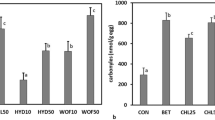Abstract
Eggs of nesting birds situated in peripheral areas serving as fire breaks are at risk of being sprayed with fire control chemicals. Acute toxicity tests were conducted by immersing northern bobwhite quail eggs for 10 s in different water-based concentrations of Silv-Ex® (SE), a foam-suppressant chemical, and Phos-Chek® G75-F (PC), a fire retardant chemical, on day 4 or day 11 of incubation. An attempt was made to relate the treatment concentrations to the actual field application levels. Mortality appeared higher in most groups exposed on day 11 than on day 4, suggesting that on day 11 the extensive chorioallantoic vascular network permitted greater uptake of chemical. Only 24–60% of the embryos survived to hatch at exposure concentrations of 202, 269, and 454 g/L PC when treated on incubation day 11. At higher concentrations including 681, 956, and 1,211 g/L PC, the compound did not completely dissolve in water and clumped on eggshells, resulting in greater hatching success. Exposures to SE at 100 g/L on incubation day 11 did not significantly affect hatching success of embryos but did significantly reduce the percent hematocrit in blood compared with controls. Incubation day 11 exposure to 202 and 1,211 g/L PC led to a significant increase in plasma aspartate aminotransferase, and day 4 exposure to 1,211 g/L PC resulted in a significant increase in alanine aminotransferase. In addition to elevated liver enzymes, these treatments resulted in a decrease in the number of hepatocyte profiles (1,211 g/L PC at day 4 and day 11) and an increase in hepatocyte size (202 and 1,211 g/L PC at day 11) in hatchlings. A combination of SE and PC was synergistic (202 g/L PC and 50 g/L SE) at day 11 of incubation with respect to decreased hatching success and reduced bone lengths. However, lower concentrations of SE (10 g/L or 30 g/L) combined with 202 g/L of PC appeared antagonistic. This may be due to SE, as a surfactant, altering the ability of PC to penetrate the egg. Our results show fewer adverse effects following exposure to SE than to PC; therefore application of SE may be less harmful to breeding bird populations.
Similar content being viewed by others
Author information
Authors and Affiliations
Additional information
Received: 19 October 2001/Accepted: 25 March 2002
Rights and permissions
About this article
Cite this article
Buscemi, D., Hoffman, D., Vyas, N. et al. Effects of Phos-Chek G75-F and Silv-Ex on Developing Northern Bobwhite Quail (Colinus virginianus). Arch. Environ. Contam. Toxicol. 43, 0330–0337 (2002). https://doi.org/10.1007/s00244-002-0218-3
Issue Date:
DOI: https://doi.org/10.1007/s00244-002-0218-3



